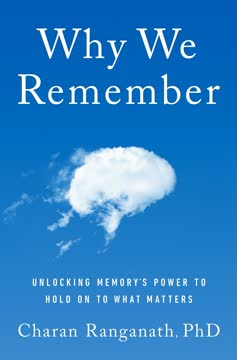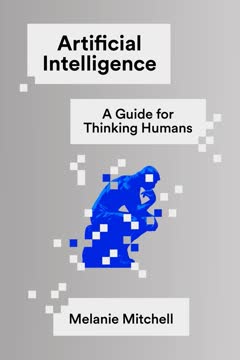Key Takeaways
1. Language is like charades: improvised communication
Language is essential to what it means to be human, yet we rarely give it a second thought.
Charades as metaphor. Language functions similarly to the game of charades, where players improvise gestures to convey meaning. This comparison highlights the creative, flexible nature of human communication. Like in charades, language users must adapt their signals to the immediate context and shared knowledge with their audience.
Collaborative meaning-making. Communication is not a simple transfer of information from sender to receiver. Instead, it's a collaborative process where both parties contribute to creating meaning. This view challenges traditional models of language that see it as a fixed code. The "communication iceberg" concept illustrates how much of our understanding relies on shared cultural and social knowledge, not just the words themselves.
Improvisation and convention. While language allows for endless creativity, it also develops conventions over time. These conventions emerge from repeated interactions, becoming more standardized but still allowing for flexibility. This balance between innovation and tradition enables language to adapt to new communicative needs while maintaining mutual understanding.
2. The Now-or-Never bottleneck shapes language processing
To get an intuitive feel for how chunking works in language, read the following string of random letters aloud to yourself, then close your eyes and try to recall as many of the letters as you can in the right order.
Cognitive limitations. Human brains have severe limitations in processing and retaining linguistic input. This "Now-or-Never bottleneck" forces us to rapidly chunk incoming language into meaningful units to avoid losing information.
Chunking strategy. To overcome these limitations, our brains employ a chunking strategy:
- Convert sounds into phonemes or syllables
- Combine these into words
- Group words into phrases
- Assemble phrases into sentences
- Integrate sentences into discourse
Just-in-time production. When speaking, we use a "just-in-time" strategy, planning and producing language in small increments rather than formulating entire sentences in advance. This approach mirrors the chunking process in comprehension and allows for fluid, adaptable communication despite cognitive constraints.
3. Meaning in language is fluid and context-dependent
The meaning of a word comes from how we use it in conversation.
Contextual interpretation. Words don't have fixed, essential meanings. Instead, their significance is determined by how they're used in specific contexts. This fluid nature of meaning allows for creative and flexible communication but can also lead to misunderstandings.
Family resemblances. Rather than having clear-cut definitions, words often have a network of related meanings, like a family with various shared traits. For example, the word "light" can refer to:
- Weight (a light package)
- Color (light blue)
- Intensity (light traffic)
- Complexity (light reading)
Metaphorical extension. Language constantly evolves through metaphorical extensions of existing words and concepts. This process allows us to talk about abstract ideas using concrete terms, facilitating complex thought and communication.
4. Language emerges through spontaneous order, not design
Language is not an isolated ability that can be damaged selectively, though it can be impaired when some of its many underlying skills are disrupted.
Emergent patterns. The complex patterns in language are not the result of deliberate design but emerge spontaneously from countless interactions over time. This process is similar to how complex patterns arise in nature or economics without central planning.
Grammaticalization. One key mechanism in language evolution is grammaticalization, where:
- Content words become function words
- Word order becomes fixed
- Loose word combinations become set phrases
Edge of chaos. Language exists at the "edge of chaos," balancing between rigid structure and complete disorder. This state allows for both stability in communication and adaptability to new needs.
5. Language evolves culturally, not biologically
Language gave rise to a completely new type of evolutionary process: the evolution not of genes but of culture.
Cultural evolution. Language changes much faster than biological evolution, making it unlikely that specific language features are encoded in our genes. Instead, languages adapt to fit the human brain through cultural transmission.
Brain-language co-evolution. While language itself isn't genetically encoded, the capacity for language likely co-evolved with increasing brain size and cognitive abilities. This created a "virtuous circle" of growing social complexity and linguistic sophistication.
FOXP2 gene. Despite initial excitement, research on the FOXP2 gene shows it's not a "language gene" but likely plays a role in general cognitive abilities that support language use.
6. Children learn language by following others' footsteps
To learn language, the child must jump into a linguistic game and start playing.
C-learning vs. N-learning. Language acquisition is a form of C-learning (cultural learning) rather than N-learning (learning about the natural world). Children aren't trying to discover abstract grammatical rules but to coordinate their behavior with others in their community.
Following footsteps. Children learn language by following in the footsteps of previous generations. This explains how they can acquire complex linguistic patterns without explicit instruction or innate knowledge.
Practice and interaction. Successful language learning requires:
- Extensive practice (tens of thousands of hours)
- Engaged, back-and-forth interactions
- Exposure to language in meaningful contexts
7. Language diversity reflects human creativity and adaptability
If we broaden our scope to consider brains from across the animal kingdom... the differences in the anatomy of the nervous system among species, and especially in the size of the brain, are substantial.
Linguistic variation. The world's languages show enormous diversity in:
- Sounds (e.g., clicks, tones)
- Grammar (e.g., word order, case systems)
- Vocabulary (e.g., color terms, kinship terms)
- Conceptual categories (e.g., time, space)
Adaptive diversity. This variation reflects the adaptability of human language to different environments, cultures, and cognitive preferences. It demonstrates the creative potential of human communication.
Individual differences. Even within a single language, there's significant variation between individuals in vocabulary, grammar use, and overall proficiency. Each person essentially speaks their own unique "idiolect."
8. Language catalyzed human cultural evolution
Language allows human skills, knowledge, social rules, and religious beliefs to accumulate at an astonishing and ever-increasing rate.
Cultural accumulation. Language enables the rapid transmission and accumulation of knowledge across generations. This capability sets humans apart from other species and drives cultural evolution.
Shaping thought. Language influences how we think about and perceive the world. For example:
- Mathematical concepts like "zero"
- Color categories
- Spatial reasoning
Collective intelligence. By connecting human minds, language vastly expands our collective problem-solving abilities. It underlies the development of complex social structures, technologies, and abstract thought.
Human-Artificial Intelligence challenge. The charades-like nature of human language poses significant challenges for AI language understanding. Current AI systems, while impressive in some tasks, lack the deep contextual understanding and improvisational abilities that characterize human communication.
</most_relevant_traits>
Last updated:
FAQ
What's The Language Game about?
- Exploration of language origins: The Language Game investigates how language emerged through improvisation and social interaction, likening it to a series of communicative games where meaning is constructed in the moment.
- Cultural evolution focus: The authors, Morten H. Christiansen and Nick Chater, argue that language is shaped by cultural evolution rather than biological adaptations, emphasizing the collaborative nature of language learning.
- Interplay of chaos and order: The book discusses how linguistic order arises from chaotic interactions, leading to the establishment of grammatical rules and conventions over time.
Why should I read The Language Game?
- Revolutionary perspective: The book challenges traditional notions of language as a fixed system, encouraging readers to rethink their understanding of communication and language development.
- Interdisciplinary insights: Drawing from linguistics, psychology, and cognitive science, the book offers a comprehensive understanding of how language functions in human society.
- Practical implications: The ideas presented have applications in education and artificial intelligence, informing teaching methods and AI development.
What are the key takeaways of The Language Game?
- Language as improvisation: Language is portrayed as a dynamic process of improvisation shaped by social interactions, highlighting the creativity in everyday communication.
- Cultural over biological evolution: The book posits that language evolves culturally, challenging the idea of a specific "language gene" and emphasizing pre-existing cognitive skills.
- Importance of context: Meaning in language is context-dependent, relying on shared knowledge and past interactions, with cultural norms playing a crucial role.
How does The Language Game redefine language learning?
- Learning through charades: Language learning is likened to playing charades, where individuals improvise and adapt communication based on context and audience.
- Chunking and constructions: Learners break down complex input into manageable chunks, or constructions, which can be reused and adapted for effective language navigation.
- C-learning vs. N-learning: The book distinguishes between C-learning (cultural conventions) and N-learning (natural world), emphasizing the collaborative nature of language acquisition.
What is the significance of the charades metaphor in The Language Game?
- Communication as a game: The charades metaphor emphasizes language as a game of improvisation, where meaning is constructed collaboratively in real-time.
- Focal points in interaction: Language users rely on shared expectations to convey meaning, highlighting the importance of context and social cues.
- Dynamic nature of language: The metaphor illustrates how language evolves through repeated interactions, with new meanings and patterns emerging over time.
What role does improvisation play in language according to The Language Game?
- Central to communication: Improvisation allows for flexibility and creativity in expressing ideas, making language rich and adaptable.
- Emergence of meaning: Meaning is created in the moment through improvisational exchanges, reflecting the social nature of language.
- Cultural evolution: Improvisation contributes to language's cultural evolution, generating new forms and meanings through social interactions.
How do the authors of The Language Game view the role of cultural evolution in language?
- Cultural evolution as central: Cultural evolution is fundamental to understanding language development, shaped by collective experiences and interactions.
- Tailoring language to abilities: It tailors language to fit human cognitive abilities, creating focal points that facilitate communication across generations.
- Language as a dynamic system: Language is presented as a dynamic system evolving through cultural transmission, highlighting its fluidity and adaptability.
What is C-learning and how does it differ from N-learning in The Language Game?
- C-learning Defined: C-learning involves learning language through social interactions and cultural context, emphasizing community and shared experiences.
- N-learning Explained: N-learning suggests language acquisition is driven by innate grammatical rules, focusing on individual cognitive processes.
- Key Differences: C-learning emphasizes social interaction, while N-learning suggests a solitary, rule-based approach to language learning.
How does The Language Game address the complexity of language?
- Spontaneous order from chaos: Linguistic complexity arises from chaotic interactions, with patterns emerging through repeated use.
- Grammaticalization process: Concrete words evolve into grammatical structures over time, illustrating language's complexity and nuance.
- Idiosyncrasies and exceptions: Language is filled with quirks and exceptions, challenging the notion of a perfect linguistic system.
What implications does The Language Game have for artificial intelligence?
- Challenges for AI: The improvisational nature of human language makes it difficult for AI to replicate genuine communication, as understanding context and nuance is essential.
- Language as a cultural product: Language is a cultural invention shaped by human interactions, suggesting AI must account for social and cultural dimensions.
- Future of AI communication: Insights from the book can inform AI development to better mimic human-like communication by recognizing improvisation and context.
What experimental methods do the authors use to support their arguments in The Language Game?
- Game-of-Telephone Experiments: These experiments simulate language evolution, showing how language changes through social transmission.
- Artificial Language Studies: Participants learn artificial languages, revealing how linguistic structures emerge spontaneously over generations.
- Memory and Chunking Research: The authors explore how memory limitations influence language learning, highlighting cognitive processes involved.
What are the best quotes from The Language Game and what do they mean?
- “Language is like a game of charades”: This quote emphasizes the improvisational and collaborative nature of communication, suggesting meaning is constructed in the moment.
- “The spontaneous emergence of linguistic order is a story as remarkable as the emergence of life itself”: It highlights the complexity and beauty of language evolution, drawing parallels with natural processes.
- “Language is perhaps humanity’s greatest accomplishment”: This statement underscores language's significance in human culture, reflecting its role in enabling progress and connection.
Review Summary
The Language Game challenges traditional theories of language acquisition, proposing that language evolves through improvisation and social interaction, akin to a game of charades. Reviewers praise its innovative approach and engaging examples, though some note repetition and lack of sociological awareness. The book explores language's role in human evolution, AI, and cultural development. While most found it fascinating and thought-provoking, a few criticized its dismissal of established linguistic theories and limited discussion of language technologies. Overall, it offers a fresh perspective on language's origins and significance.
Similar Books










Download PDF
Download EPUB
.epub digital book format is ideal for reading ebooks on phones, tablets, and e-readers.





